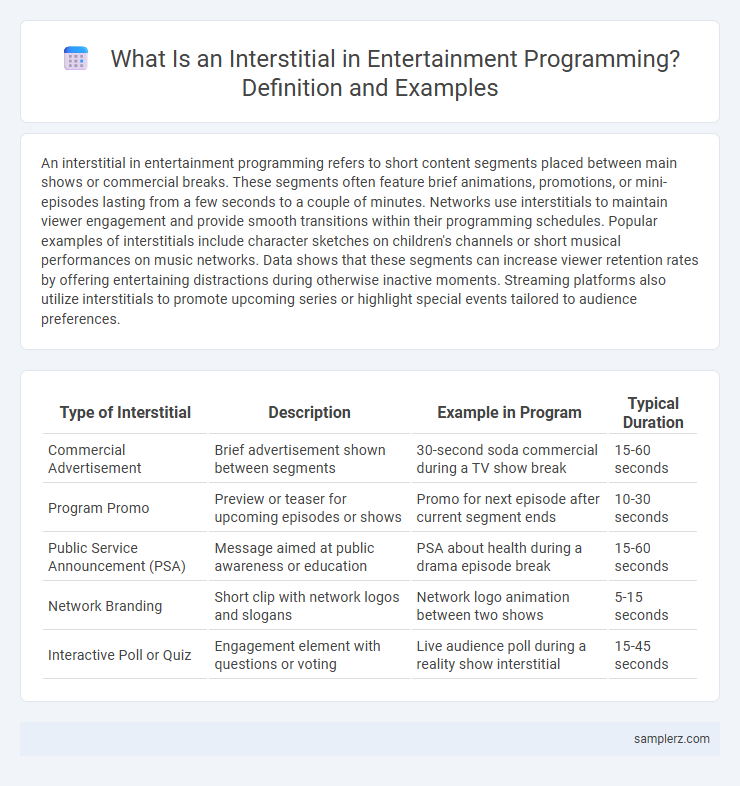An interstitial in entertainment programming refers to short content segments placed between main shows or commercial breaks. These segments often feature brief animations, promotions, or mini-episodes lasting from a few seconds to a couple of minutes. Networks use interstitials to maintain viewer engagement and provide smooth transitions within their programming schedules. Popular examples of interstitials include character sketches on children's channels or short musical performances on music networks. Data shows that these segments can increase viewer retention rates by offering entertaining distractions during otherwise inactive moments. Streaming platforms also utilize interstitials to promote upcoming series or highlight special events tailored to audience preferences.
Table of Comparison
| Type of Interstitial | Description | Example in Program | Typical Duration |
|---|---|---|---|
| Commercial Advertisement | Brief advertisement shown between segments | 30-second soda commercial during a TV show break | 15-60 seconds |
| Program Promo | Preview or teaser for upcoming episodes or shows | Promo for next episode after current segment ends | 10-30 seconds |
| Public Service Announcement (PSA) | Message aimed at public awareness or education | PSA about health during a drama episode break | 15-60 seconds |
| Network Branding | Short clip with network logos and slogans | Network logo animation between two shows | 5-15 seconds |
| Interactive Poll or Quiz | Engagement element with questions or voting | Live audience poll during a reality show interstitial | 15-45 seconds |
What Is an Interstitial in Entertainment Programs?
An interstitial in entertainment programs refers to short segments or brief content pieces inserted between main program elements, such as commercials, shows, or scenes, to maintain viewer engagement. These segments often include animations, trivia, promos, or character interactions designed to bridge transitions smoothly and enhance the overall viewing experience. Interstitials play a crucial role in pacing, keeping audience attention during breaks, and providing supplementary entertainment without interrupting the program flow.
Notable Interstitials in TV History
Notable interstitials in TV history include the brief, distinctive segments like the classic MGM lion roar and the iconic NBC chimes that helped establish network identities. Memorable interstitials also feature animated bumpers such as Nickelodeon's orange splat and PBS's "Ready to Learn" segments designed to engage viewers between shows. These interstitials serve as crucial branding tools, enhancing viewer retention and creating a seamless transition within programming blocks.
Types of Interstitial Content Used in Programs
Interstitial content in entertainment programs includes brief segments such as animated bumpers, sponsor messages, and short informational clips that bridge main content. These interstitials serve to maintain viewer engagement during transitions, often featuring branded visuals or thematic music to reinforce program identity. Common types include promotional teasers, trivia facts related to the show, and audience interaction prompts designed to enhance the overall viewing experience.
Creative Examples of Interstitial Segments
Interstitial segments in entertainment programs often feature quick, creative bursts such as animated character interactions or themed mini-games that maintain audience engagement between main content. Examples include short musical performances or celebrity interviews tailored to the show's brand identity, enhancing viewer retention and channel loyalty. These innovative interstitials capitalize on unique visuals and catchy audio to create memorable transitions that complement the program's narrative flow.
How Interstitials Enhance Viewer Engagement
Interstitials, such as brief animated clips or branded messages inserted between program segments, capture viewer attention and create natural breaks that prevent fatigue. These short interruptions enhance viewer engagement by reinforcing brand recall and increasing anticipation for upcoming content. Effective use of interstitials leads to higher viewer retention rates and improved overall program flow.
Iconic Animated Interstitials in Children's Shows
Iconic animated interstitials in children's shows, such as the whimsical "Pepe the King Prawn" breaks in *The Muppet Show* or the colorful, rhythmic "Schoolhouse Rock!" segments, captivate young audiences by seamlessly bridging scenes with engaging visuals and catchy tunes. These interstitials enhance programming flow while reinforcing educational or entertainment themes, fostering brand identity and memorable viewing experiences. Classic examples also include the playful "Blue's Clues" animated callouts, which combine simple animation with interactive prompts to maintain children's attention between main segments.
Use of Interstitials in Live Events and Award Shows
Interstitials in live events and award shows serve as dynamic transitions between segments, enhancing viewer engagement with short, visually captivating content. These interstitials often include sponsor messages, promotional teasers, or thematic animations tailored to maintain the event's momentum without interrupting the live experience. Effective use of interstitials can boost audience retention and provide valuable branding opportunities during high-profile broadcasts.
Role of Interstitials in Streaming Platforms
Interstitials in streaming platforms serve as brief, often interactive segments that enhance user engagement by providing seamless transitions between content. These short videos or ads deliver targeted promotions, updates, or show highlights without disrupting the viewing experience. By increasing viewer retention and offering monetization opportunities, interstitials play a crucial role in the platform's content delivery strategy.
Memorable Musical Interstitials in Television
Memorable musical interstitials in television often serve as brief, catchy melodies or theme snippets that bridge segments, enhancing viewer engagement and program flow. Classic examples include the iconic musical cues in "Sesame Street" that link educational content, and the jazzy interludes in "The Fresh Prince of Bel-Air" which transition scenes seamlessly. These musical interstitials leverage recognizable tunes to reinforce branding and evoke emotional connections, making them essential elements in television entertainment.
Evolution of Interstitials in Modern Programming
Interstitials in modern programming have evolved from simple static screens to dynamic, context-aware content that enhances user engagement without interrupting the experience. Early interstitials primarily displayed advertisements or basic promotions, while contemporary versions integrate rich media, personalized messages, and interactive elements based on real-time data analytics. This evolution reflects advancements in AI-driven targeting and adaptive design, optimizing viewer retention and monetization strategies within entertainment platforms.

example of interstitial in program Infographic
 samplerz.com
samplerz.com